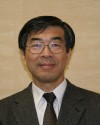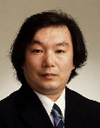 |
 |
 |
Professor |
Assistant Professor |
Assistant Professor |
- Formal language and automata;
- Term rewrite systems;
- Declarative languages;
- Formal semantics of languages;
- Computation mechanisms and modeling; and
- Discrete mathematics.
The research in this laboratory is divided into two parts:
The first part consists of the work that follows the research in the above areas. One of the most important goal of it is to provide the foundations for the education of language processing systems, programming languages, and formal language theory.
The second part is the creative study in some specific areas related to language processing systems. The research activities of this part are based on the voluntary work of each faculty member. Currently, we are working on
- Characterizations of language classes;
- Foundation and implementation of declarative programming languages, such as functional, logic and functional-logic programming;
- Operational semantics of declarative languages;
- Parallel/Distributed computation systems, such as compiler design for vector/matrix parallel computer architecture;
- Others related to language processing systems;
- Visualization techniques for abstract models; and
- Applications of random walk model.
Functional languages based on reduction have several properties such as deterministic and lazy evaluation and higher order definitions, but they lack other useful properties such as partial data structure and logical variables. On contrary logic languages based on unification allow partial data structure and logical variables but lack deterministic and lazy evaluation as well as higher order definitions. From this point of view it seems natural to unify both languages into one paradigm in order to obtain a language, called a functional logic language, with more expressive power than both functional and logic languages. The members of this laboratory engage to develop an efficient operational semantics for such unified model.
It is recognized that narrowing is one of the most important mechanisms of computation, especially in functional-logic programming languages. The members of this laboratory study theoretical aspects of narrowing, extension of the notion of narrowing to higher-order narrowing, and others.
The recent parallel/distributed computation environment requires the development of a new language model and its processing model/system for such environment. To design new languages and language processing systems is the key work for the next development of the computer society and it is considered to be one of the most important subjects for this laboratory to study for establishing such models and implementing as real systems for evaluation.
Random walk model has many useful applications such as modeling the transport of molecules in physics, the locomotion of organisms in biology, and the ants behavior in its foraging. Furthermore, study of visual simulation of such systems is also conducted by the member of this laboratory.
The education on the subjects related to languages and language processing systems is also the important mission of this laboratory. The courses for undergraduate students given by the members of this laboratory include Computer Literacy II, Advanced Algorithm, Automata and Languages, Language Processing Systems, and Logics. Those for graduate students include Automata and Languages and Compilers, Advanced Automata and Languages, Computation Models, Term Rewriting Systems, and Declarative Processing.
| The research and education activities in this laboratory focus on the theoretical and practical aspects related to language processing and language processing systems. In particular, our work covers the following areas. |
Refereed Journal Papers
| [hamada-01:2006] |
Mohamed Hamada. A web-based tools for active learning in
information theory. ACM SIGCSE, 39(1), 3 2007. |
| ACM |
[hamada-02:2006] |
Mohamed Hamada. Visual tools and examples to support active
e-learning and motivation with performance evaluation. Lecture Notes in
Computer science, 3942, 2006. |
| Springer |
[okawa-01:2006] |
S.Watanabe and S. Okawa. An Extended Star graph: A Proposal
of a New Network Topology and Its fundamental Properties. Int. J.
Computational Science and Engineering, 2(1/2):32.36, 2006. |
| In the past years, various network architectures for parallel computers have been
proposed, for example, hyper cubes or star graphs. These classes of networks are
known as Cayley graphs. In recent years, there have been some proposals of new
families of interconnection networks, namely, constant degree networks. In this
paper, a new interconnection network named extended star graphs is proposed,
and it is proved that the extended star graphs have hypercube structure. We
also provide a routing algorithm for node-to-node communication on extended
star graphs. Based on the algorithm, we obtain an upper bound 2n - 1 on the
diameter for the n-th order extended star graph. |
[okawa-02:2006] |
S. Okawa and S. Hirose. The relation among Watson-Crick Automata
and Their Relations with Context-Free Languages. IEICE Trans.
Inf. & Syst., E89-D(10):2591.2599, 2006. |
| Watson-Crick automata were introduced as a new computer model and have
been intensively investigated regarding their computational power. In this paper,
aiming to establish the relations among language families defined by Watson-
Crick automata and the family of context-free languages completely, we obtain
the following results. (1) F1Wk = FSWK = FWK, (2) FWK = AWK, (3)
there exists a language which is not context-free but belongs to NWK, and (4)
there exists a context-free language which does not belong to AWK. |
[taro-01:2006] |
Satoshi Okui and Taro Suzuki. Pattern Matching of Incompletely
RE-Typed Expressions via Transformation. IPSJ Transactions on Programming,
47(SIG 6 (PRO29)):37.49, 2006. |
| We offer a pattern matching algorithm based on incompleteregular expression
(IRE, for short) types. Pattern matching forIRE-typed expressions provides a
capability to uniformly accessfcontextf parts of XML document tree within a
framework ofpattern matching theory. We present our algorithm as a set ofa few
simple transformation rules. They simulate a transitionin non-deterministic topdown
tree automata, while alsoaccumulating bindings for pattern variables.Our
pattern matching algorithm is sound and complete; itenumerates all correct
but no incorrect solutions.We give rigorous proofs of those properties. A small
butnon-trivial example illustrates the expressiveness of our framework. |
Referred Proceeding Papers
| [hamada-03:2006] |
Mohamed Hamada. A model and analysis for ants-like agents.
In IEEE International Conference on Information and Communication
Technologies: From Theory to Applications, 2006. |
| IEEE |
[hamada-04:2006] |
Bhagyavati, Ghemri, Taylor, and M. Hamada. Experiences Involving
Undergraduates in Research. In 14th International Conference
on Telecommunication Systems Modeling and Analysis, 2006. |
| Penn State University |
Academic Activities
| [hamada-05:2006] |
M Hamada, 2006. ACM Member, SIGCSE and ITiCE Reviewer |
| [hamada-06:2006] |
M Hamada, 2006. IEEE Member, IEEE ITHET and IEEE ICICTA Reviewer |
| [okawa-03:2006] |
S Okawa, 2006. Reviewer of IEICE Transaction |
| [taro-02:2006] |
Taro Suzuki, 2006. Reviewer of Journal of Symbolic Computation |
| [taro-03:2006] |
Taro Suzuki, 2006. Member, ACM |
| [taro-04:2006] |
Taro Suzuki, 2006. Member, JSSST |
| [taro-05:2006] |
Taro Suzuki, 2006. Member, PSJ |
Ph.D. and Other Theses
| [hamada-07:2006] |
Kenta Hayashi. Graduation Thesis: Improved Finite State
Machine Simulator, 2006. Thesis Advisor: Mohamed Hamada |
| [okawa-04:2006] |
Kazuaki Hamawatari. Master Thesis: On the Fundamental Properties
of Mark-Block-Reverse Graphs, University of Aizu, 2007. Thesis Advisor: Okawa, S. |
| [okawa-05:2006] |
Manabu Nemoto. Master Thesis: On the Possibility of language
Definition by Chemical Reaction Model: Experimental Results by Cellular
Automata, University of Aizu, 2007. Thesis Advisor: Okawa, S. |
| [okawa-06:2006] |
Tomoyuki Kitamura. Master thesis: A Second-Order Matching
Algorithm for XML Transformation, University of Aizu, March 2007. Thesis Advisor: Taro Suzuki |
| [taro-07:2006] |
Yuutaro Ogasawara. Graduation thesis: Java implementation of
XML transformation system with Incomplete Regular Expression Types,
University of Aizu, March 2007. Thesis Advisor: Taro Suzuki |
| [taro-08:2006] |
Naoki Eda. Graduation thesis: Implementation of Generic Functions
to Control CPU Responses Using Haskell, University of Aizu, March
2007. Thesis Advisor: Taro Suzuki |
